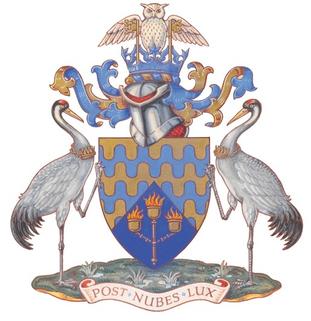College of Aeronautics, Cranfield

Cranfield University coat of arms
|
|
|
Former names
|
Cranfield Institute of Technology College of Aeronautics Silsoe College Royal Military College of Science |
|---|---|
| Motto | Latin: Post Nubes Lux; "Out of darkness, light" |
| Type | Public |
| Established | 1946, incorporated by Royal Charter in 1969 |
| Chancellor | Baroness Young of Old Scone |
| Vice-Chancellor | Sir Peter Gregson |
| Visitor | HRH The Duke of Kent |
|
Administrative staff
|
1,800 |
| Students | 3,980 (2015/16) (all postgraduates) |
| Location | Cranfield, Bedfordshire Shrivenham, Oxfordshire England |
| Campus | Rural (both) |
| Colours | |
| Affiliations | ACU, PEGASUS |
| Website | http://www.cranfield.ac.uk/ |
Cranfield University is a British postgraduate and research-based public university specialising in science, engineering, technology and management. It contains two campuses; the main campus is at Cranfield, Bedfordshire, and the second is the Defence Academy of the United Kingdom at Shrivenham, southwest Oxfordshire. The main campus is unique in the United Kingdom for having a semi-operational airport (Cranfield Airport) on campus. The airport facilities are used by Cranfield University's own aircraft in the course of aerospace teaching and research.
Cranfield was founded as the College of Aeronautics in 1946, and became a university in its own right as the Cranfield Institute of Technology in 1969.
Cranfield University was formed in 1946 as the College of Aeronautics, on the former Royal Air Force base of RAF Cranfield, which opened in 1937. Together with other individuals, Stafford Cripps was instrumental in the foundation of the original college in 1946, from which the university developed. The Vice-Chancellor's building is known as "Stafford-Cripps".
Between 1955 and 1969 a period of diversification took place. In 1967 the college presented the Privy Council with a petition for the grant of a Royal Charter along with a draft charter for a new institution to be called Cranfield Institute of Technology.
The Cranfield Institute of Technology was incorporated by Royal Charter in 1969, giving the institution its own degree-awarding powers.
Since then the former National College of Agricultural Engineering established at Silsoe near Luton, Bedfordshire, in the 1960s, was incorporated. This was relocated to the Cranfield campus and closed for teaching undergraduates in 2007 whilst retaining some postgraduate courses.
...
Wikipedia
